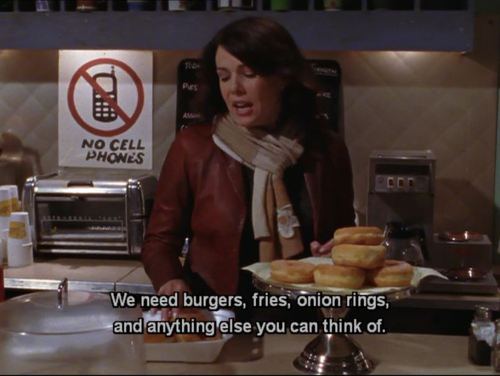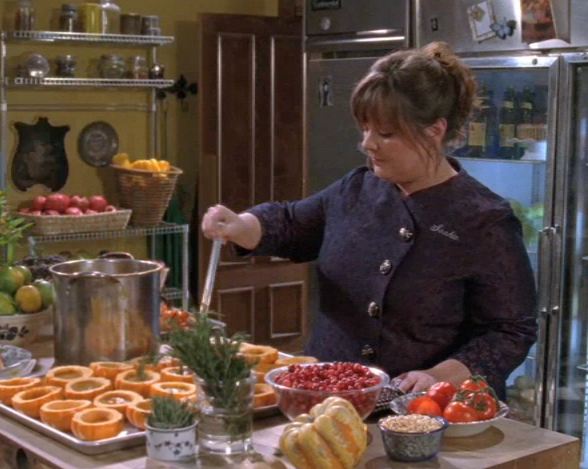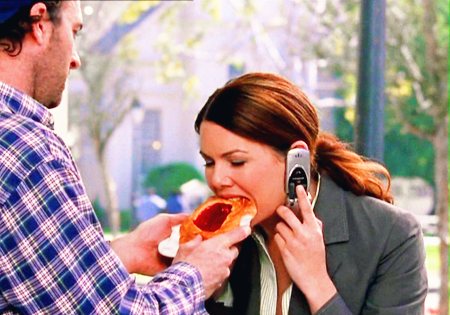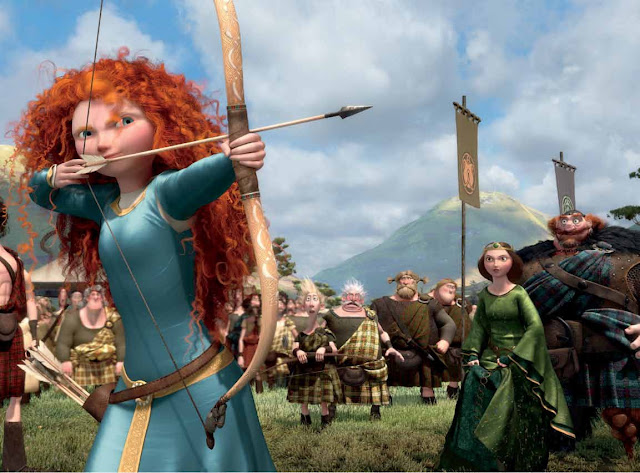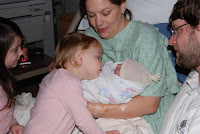Guest post written by Amanda Rodriguez.
The long-running TV series The Gilmore Girls followed the lives of a single mother who got pregnant at 16 and her daughter as they live and grow in a small town. The mother and daughter duo (Lorelai& Rory) are unconventional, confident, independent, smart, capable, and fun-loving. In Lorelai’s words, “That’s because I’m not orthodox. I’m liberal with a touch of reform and a smidgen of zippity-pow.” The way in which Lorelai and Rory relate to food, however, is a complex issue that can function as a microcosmic reading of the entire show.
First of all, it’s important to establish Rory and Lorelai’s eating habits.
The Gilmore Girls like junk food.
The pair is infamous for not knowing how to cook and always ordering take-out or going out to eat. They eat burgers, pizza, or Chinese food for dinner nearly every night. For breakfast, it’s donuts, pancakes, bacon, pop tarts, or four bowls of cereal. They avoid vegetables at all costs. When they have movie nights (which is often), they stock up on a bevy of sugary snacks, including (but not limited to) Red Vines, marshmallows, cheesy puffs, potato chips, tater tots, and mallowmars. Not only that, but they drink copious quantities of coffee. Refusing to eat any sort of healthy food while indulging consistently in junk food is only half of it…
The Gilmore Girls can seriously eat.
This mother/daughter team has the capacity to consume mass quantities of food, out-eating their much larger male counterparts. They’re always up for round three or even four when the boys have thrown in the towel. In addition, they despise exercise and ridicule other women who either enjoy or feel compelled to workout.
Other characters constantly crack jokes that revolve around their disbelief surrounding the quality
and quantity of the food the Gilmore Girls consume. The Gilmore Girls themselves refer to their eating habits with startling frequency. In fact, their diet is referred to in one way or another in nearly every single episode. Why is this theme so central?
Ostensibly, the way the Gilmore Girls eat is intended to be commensurate with the way in which they live their lives. Lorelai is not a traditional mother. She doesn’t grocery shop for healthy foods; nor does she prepare meals.
Lorelai’s refusal to conform to what society expects a mother to cook is symbolic of her rebellion against society’s expectations of what a mother should be. Instead, Lorelai is a hot, fast-talking, coffee guzzling, career-oriented woman whose relationship with her daughter is more like that of a friend than a parent. She encourages her daughter to think for herself and to make her own decisions. Both Lorelai and her daughter are extremely successful and well-respected with an intense emotional bond, proving that their unconventionality is not only endearing, but it works.
The pair’s notorious consumption habits act as a rejection of the notion that women must be so body obsessed that they strictly monitor their food intake, which can devolve into an unhealthy eating disorder and/or suck the enjoyment out of food and of life. These two women flaunt a freedom, self-acceptance, and pleasure-seeking attitude that are all expressed through their love of food.
 |
| Rory (Alexis Bledel) and Lorelai (Lauren Graham) in Gilmore Girls |
Rory and Lorelia embrace the lowest common denominator types of food, preferring high quantity and low quality. Though Lorelai was raised in a wealthy household, she has rejected the upper class lifestyle. When eating their weekly Friday night dinners with Lorelai’s parents (Emily & Richard Gilmore), Lorelai and Rory often have trouble eating or enjoying the gourmet delicacies that they’ve been served. This is an expression of the way in which they’ve embraced their working class status.
Unfortunately, this is where the positive interpretations of the Gilmore diet end. On the surface, eating junk food and tons of it may seem subversive in its rejection of traditional values surrounding womanhood, motherhood, and class, but it is, in truth, an enactment of the male fantasy of the beautiful, slender woman who loves to eat and doesn’t worry about her weight. Within this context, their eating habits seem more in-line with an idealized concept of womanhood rather than a dismissal of it.
 |
| Gilmore Girls |
The most disturbing and possibly damaging facet of the Gilmore diet is that it is patently unrealistic. Yes, there are thin women out there who have naturally high metabolisms or don’t exercise or prefer junk food. The combination of all three, however, is rarer. Regardless, there is a distinction between weight and health. For example, someone can be“underweight” or at “optimum weight” and be unhealthy, while another person can be “overweight” and still be healthy. It’s hard to imagine a nutrient deficient lifestyle like the one the Gilmore Girls practice resulting in copious energy, brain power, and a healthful appearance.
If so much focus wasn’t placed on Rory and Lorelai’s diet, we could chalk all this up to the combination of “good genes” (as often claimed on the show), a cute personality quirk, and Hollywood magic. The emphasis on the Gilmore diet, however, ends up creating yet another unrealistic expectation of how women should be and look. Many women lament online that they
wish they could eat like the Gilmore Girls and not gain weight. Blogger with the handle“Leah (The Kind of Weight Watcher”) even created something she calls “
The Gilmore Girls Diet” where she lays out her plan to eat like the Gilmore Girls in an attempt to lose weight. Even Lauren Graham (the actress who portrays Lorelai)
struggles with food, her weight, and self-confidence. Not only that, but she loves being athletic and relies on exercise to keep her body healthy and within the Hollywood ideal. This underscores the fact that the Gilmore diet
isn’t even realistic for the Gilmore Girls themselves.
For countless women around the world suffering from eating disorders and unhealthy relationships with food, the Gilmore diet is another detrimental example of the paradox insisting women should be naturally thin and beautiful while not paying attention to what they eat or how they take care of their bodies. This paradox contributes to many women’s struggles with body image and self-worth. It also promotes a negative relationship with food, where some women no longer view food as simply life-sustaining sustenance, but as a huge force in life. Some may see food as an enemy to be managed or starved, or, conversely, some women may develop an emotional dependence on food so that they must indulge in order to derive comfort. All the positive facets of the Gilmore diet are washed away in the face of its reinforcement of unhealthy body and food issues.
Now consider how unconventional the Gilmore Girls really are. They’re well-dressed, slender, and typically attractive. They live in a quaint, small town that they adore. Rory receives an Ivy League Yale education. Lorelai has no mechanical or home repair skills so must always ask Luke (the local diner owner) to be her handyman. Even their eschewing of the upper class lifestyle has its limits; they often enjoy the benefits of having wealthy family (expensive gifts, education, trips, etc), and the two generally fit in quite well at Emily and Richard’s upper crusty social functions. They obsess over boys and men, and both of them seek traditional heterosexual romances that will lead to traditional marriage and a traditional family.
In the end, the Gilmore diet says the same thing the show itself is saying: Yes, the Gilmore Girls are quirky, independent, and smart. Yes, the Gilmore Girls refuse to bend to society’s ideas of how a woman should be and what should be expected of her. At heart, though, the Gilmore Girls
want that traditional life, and by the end of the series, they
have that traditional life. Though the Gilmore Girls
claim to be nonconformist, though they take an unconventional path to get there, they end up in the same place with the same kind of traditional life as other, less rebellious TV heroines. Their diet, like their lifestyle, may seem subversive at first glance, but instead reveals itself to be another expression of their internal acceptance of ideal, traditional womanhood.
———-
Amanda Rodriguez is an environmental activist living in Asheville, North Carolina. She holds a BA from Antioch College in Yellow Springs, Ohio and an MFA in fiction writing from Queens University in Charlotte, NC. She writes all about food and drinking games on her blog Booze and Baking. Fun fact: while living in Kyoto, Japan, her house was attacked by monkeys.







